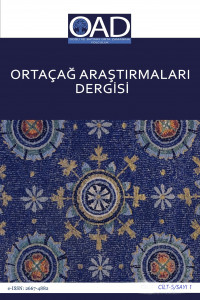Abstract
Bu makale İskenderiye’nin Endülüslü Müslüman bir grup tarafından fethini ele alır. İlgili bağlamda bu fethin ve ona ilişkin hadislerin detaylı bir şekilde incelenmesini amaçlar. Yazar öncelikle konuyla alakalı tarihi dokümanlar aracılığıyla bu fethin detaylı bir hikayesini sunar; ardından günümüze ulaşmış en eski fiten eserlerinden biri olan Nuʿaym b. Hammâd’ın Kitâbu’l-Fiten’indeki bu fetihle alakalı dokuz hadise yer verir. Eskatolojik karakterli bu hadisleri ele alırken ilk olarak içerik yönünden bir karşılaştırma yaparak burada dile getirilen kehanetlerin esasında eşzamanlı olarak yaşanan bazı olaylardan hareketle yapılmış tahminler olabileceğini iddia eder. Bunun yanı sıra içerik bakımından bu hadislerin hem birbirleriyle hem de tarihi gerçeklerle uyuşmayan birçok yönü olduğunu ortaya koyar. Daha sonra birtakım tarihlendirme yöntemleri (tpq ve taq) uygulayarak bu hadislerin ortaya çıkış tarihlerine dair bazı tespitlerde bulunur. Bu tespitler sonucunda söz konusu hadislerin tamamının Nuʿaym tarafından uydurulmadığını, onun yalnızca İskenderiye fethine dair hadisleri toplamakla yetindiğini kaydeder. Yazara göre bu uydurma faaliyetinin esas sorumluları yüksek ihtimalle isimleri eskatolojik hadislerde çokça geçen üçüncü tabakadan bazı ravilerdir; bununla birlikte Nuʿaym’ın burada esas sorumlu tutulması gereken husus bu hadislerin aktarımıyla ilgilidir; zira Nuʿaym rivayet zincirindeki kopukluğu tedlis yaparak gidermeye çalışmıştır.
Abstract
This article discusses the conquest of Alexandria by a Muslim group from al-Andalus. In the relevant context, it aims to examine this conquest and the hadı̄ths related to it in detail. The author firstly presents a detailed story of this conquest through relevant historical documents; then he cites nine hadı̄ths that related to this conquest in the Nuʿaym Ibn Ḥammād’s Kitāb al-Fitan which one of the oldest eschatological books that extant. While discussing these eschatological hadı̄ths, he first makes a comparison in terms of content and claims that the prophecies expressed here actually may be predictions based on some simultaneous events. In addition, he reveals that there are many aspects of these hadı̄ths that are inconsistent with each other and with historical facts in terms of content. Then, by applying some dating methods (tpq and taq), he makes some determinations about the emergence dates of these hadı̄ths. As a result of these determinations, he records that all the hadı̄ths in question were not fabricated by Nuʿaym and he was just content to collect the hadı̄ths about the conquest of Alexandria. According to the author, the main responsible of this fabrication are probably some narrators from the third generation, whose names are frequently mentioned in eschatological hadı̄ths; however, the issue that Nuʿaym is responsible for here is related to the transmission of these hadı̄ths; because Nuʿaym tried to eliminate the disconnection in the chain of narration by doing tadlı̄s.
Keywords
eschatology hadı̄th al-Andalus Alexandria post quem ante quem
Details
| Primary Language | Turkish |
|---|---|
| Subjects | Religious Studies |
| Journal Section | Translate Article |
| Translators | |
| Publication Date | June 26, 2022 |
| Submission Date | December 11, 2021 |
| Published in Issue | Year 2022 Volume: 5 Issue: 1 |
Cite
Articles published in Ortaçağ Araştırmaları Dergisi are licensed under a Creative Commons Attribution-NonCommercial 4.0 International License (CC BY-NC 4.0). Ortaçağ Araştırmaları Dergisi provides immediate open-access to its content, reflecting its conviction in advancing global knowledge exchange. The opinions presented in the articles are the sole responsibility of their respective authors and do not present the view or opinions of Ortaçağ Araştırmaları Dergisi. Terms of Use & Privacy Policy




